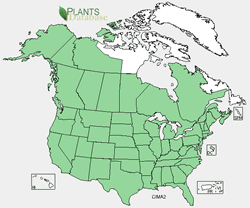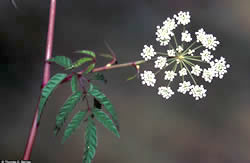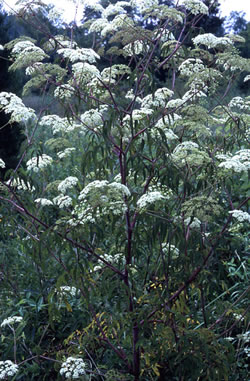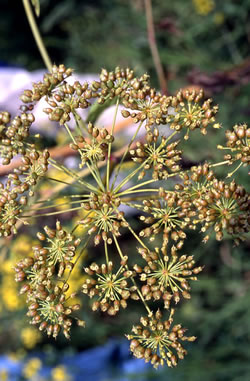Plant of the Week
 Range map of Cicuta maculata. States are colored green where the species may be found.
Range map of Cicuta maculata. States are colored green where the species may be found.
 Range map of Cicuta douglasii. States are colored green where the species may be found.
Range map of Cicuta douglasii. States are colored green where the species may be found.
 Cicuta maculata in flower. Photo by Thomas Barnes.
Cicuta maculata in flower. Photo by Thomas Barnes.
 Cicuta maculata in full flower. Photo by B. Eugene Wofford, University of Tennessee Herbarium.
Cicuta maculata in full flower. Photo by B. Eugene Wofford, University of Tennessee Herbarium.
 Close-up of mature capsules (fruit) of Cicuta maculata. Photo by B. Eugene Wofford, University of Tennessee Herbarium.
Close-up of mature capsules (fruit) of Cicuta maculata. Photo by B. Eugene Wofford, University of Tennessee Herbarium.
Water Hemlock (Cicuta maculata or Cicuta maculata (DC.) J.M. Coult. & Rose)
By Walter Fertig
Spotted or poison hemlock (Conium maculatum) is the “hemlock” that knocked off the ancient Greek philosopher Socrates. Its relative, water hemlock (Cicuta maculata or Cicuta douglasii) does not occur in southern Europe but could have been pressed into duty. Ethnobotanist H.D. Harrington once wrote that Water hemlock “has gained the reputation as being the most poisonous plant in the North Temperate Zone.” Its toxin, called cicutoxin, can cause delirium, nausea, convulsions, abdominal pain, seizures, and vomiting within 60 minutes of ingestion – frequently leading to death.
Taxonomists sometimes recognize two species of water hemlock in North America. Cicuta maculata (spotted water hemlock) in the strict sense occurs over most of North America but is replaced by Cicuta douglasii (western water hemlock) in the northwestern United States and western Canada. Both species are similar in having umbels of small white flowers borne on tall stems (up to 6 feet in height) above once to thrice pinnately compound, fern-like leaves. The leaflets of Cicuta can be distinguished from similar, non-toxic species in the parsley family (Apiaceae or Umbelliferae) by having veins that fork at their tips, with one branch ending at the tip of the leaflet and the other in the V-shaped sinus between adjacent leaflet lobes. All parts of water hemlock are toxic, but the poison is especially virulent from the roots. The lower stem and upper roots of Cicuta contain numerous internal partitions or air spaces that can be revealed if sliced lengthwise. Would-be natural food gourmands are well advised to avoid parsley-like plants with this combination of leaflet and root characteristics.
True to its common name, water hemlock occurs primarily on wet soils associated with ditches, stream banks, pond margins, and marshes. Water birds often eat the corky, rounded fruits of water hemlock without ill effect, though anecdotal reports suggest that humans who eat these same birds during migration can be sickened second-hand.

